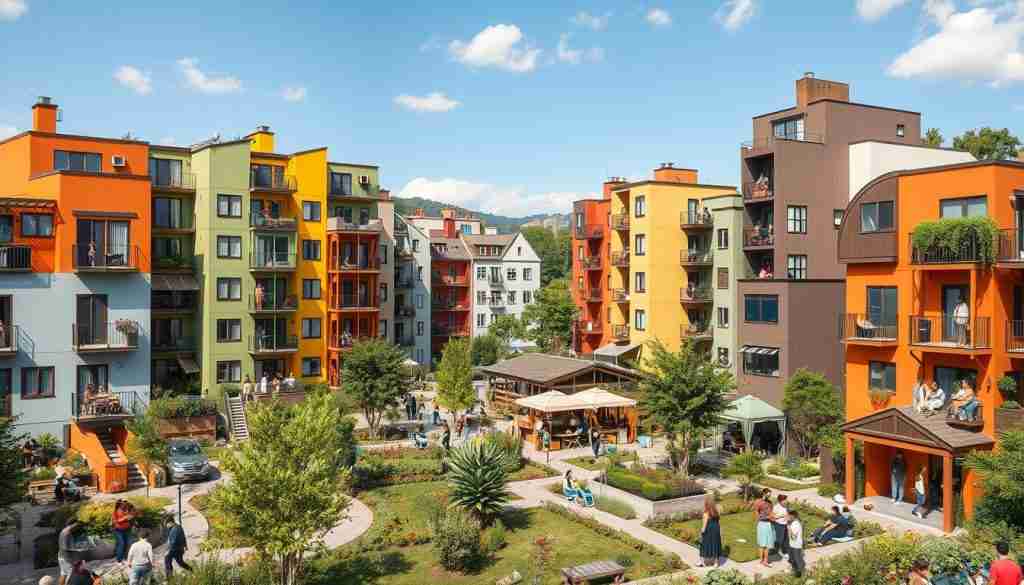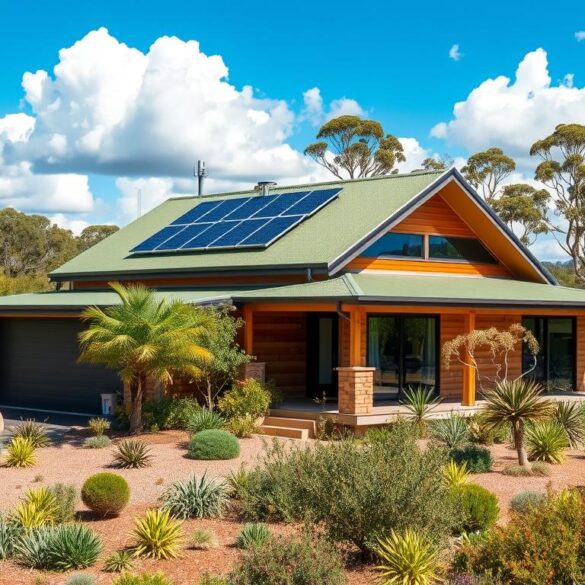In recent years, more people are choosing shared housing over traditional homes. Co-living and co-housing are two popular options. They offer different ways to live together, depending on what you prefer.
Many people get co-living and co-housing mixed up. But knowing the differences can help you pick the right community for you. This article will explain the main differences between co-living and co-housing. This way, you can choose the best fit for your lifestyle.
When looking at shared housing, think about privacy, community, amenities, and lifestyle. Co-living and co-housing have unique features. Understanding these can help you find a place where you feel supported and connected.
Key Takeaways:
- Co-living and co-housing offer distinct approaches to shared housing and communal living.
- Understanding the differences between co-living vs. co-housing is crucial for making an informed decision.
- Factors to consider include privacy, community involvement, amenities, and lifestyle fit.
- Co-living and co-housing cater to different preferences and needs within intentional communities.
- Examining the unique characteristics of each model helps in choosing the most suitable living arrangement.
Understanding the Basics of Co-Living and Co-Housing
Co-living and co-housing are new ways to live together. They offer community living for different lifestyles. These options are becoming more popular.
Defining Co-Living
Co-living is a new way to share a home. It’s for three or more people who don’t know each other. It’s popular with young people who want to meet others.
Co-living places have private rooms and shared areas. They offer services like cleaning and WiFi. You can stay for just one night, making it great for busy lives.
Defining Co-Housing
Co-housing is a community living model. It has private homes and shared spaces. People buy their homes and live there for a long time.
It’s for those who want a close community. Co-housing has spaces for events and meals. It’s for people who value community and support.
The Emergence of Alternative Living Models
Co-living and co-housing are growing because people want connection and affordable homes. They offer many benefits:
- They create a sense of community.
- They provide shared resources.
- They promote a green lifestyle.
- They can be cheaper than traditional homes.
The co-living market is growing fast, worth $93 billion. It’s expanding in many countries.
| Aspect | Statistic |
|---|---|
| Communities offering co-living spaces | 1,550 |
| Available rooms for co-living | 35,000 |
| Global presence | 65 countries, 320 destinations |
| Members in co-living communities | 87,000 |
| Reviews on co-living experiences | 33,000 |
| Monthly visitors to co-living platforms | 100,000 |
| Potential savings compared to studio living | Up to 40% |
| Community types available | 60 |
| Overall rating based on reviews | 4.9 (Excellent) |
More people are choosing collaborative housing, intergenerational living, and community-oriented housing. This trend is expected to grow. These options offer a new way to live, focusing on connection and community in a world that’s often disconnected.
Co-Living: A Modern Approach to Shared Housing
In recent years, co-living has become a hit in cities. It attracts young professionals, entrepreneurs, digital nomads, artists, and students. This modern housing option offers private rooms and shared amenities in lively communities.

Urban-Centric Accommodation Solutions
Co-living spaces are perfect for those wanting affordable housing in cities. They create a community feel, great for newcomers or those seeking easy living. Co-living encourages people to meet and network through shared spaces.
Fully-Furnished Private Rooms and Shared Spaces
Co-living provides private rooms or studios, saving you from buying furniture or setting up utilities. You also get to enjoy common areas like:
- Coworking spaces
- Lounges and terraces
- Gyms and fitness centers
- Cafes and dining areas
These amenities foster community and offer access to facilities that might be too expensive or hard to find elsewhere.
Streamlined Booking and Convenience
Booking co-living is easy and clear, unlike traditional leases. You can book online, view rooms, compare prices, and secure your spot with a few clicks.
| Feature | Co-Living | Traditional Housing |
|---|---|---|
| Lease Terms | Flexible, short-term (weeks to months) | Long-term (6-12 months or longer) |
| Furnishings | Fully-furnished rooms | Unfurnished, tenant responsible |
| Utilities | Included in the rental price | Tenant responsible for setting up and paying |
| Amenities | Extensive shared facilities (coworking spaces, gyms, cafes) | Limited, varies by property |
Co-living offers convenience and flexibility. It’s perfect for those who want a hassle-free life in a supportive community.
Co-Housing: A Collaborative Community Living Model
Co-housing is a unique way to live together, focusing on intentional communities. Residents help design and run their neighborhoods. Unlike urban co-living spaces, co-housing is often in suburbs or rural areas. This offers peace and a connection with nature.
Privately-Owned Housing Units with Shared Spaces
Co-housing combines private homes with shared areas. Residents enjoy their own space but also common facilities like kitchens and lounges. This mix promotes a sense of community and encourages neighbors to get to know each other.
Self-Organized and Managed Communities
Co-housing is run by the people who live there. Unlike regular housing, residents make decisions from start to finish. This way, they create a community that truly reflects their needs and values.
Residents share tasks like cooking and cleaning. This teamwork not only helps everyone but also builds strong bonds. Together, they create a supportive and trusting community, going beyond typical neighborly ties.
| Co-Housing Project | Location | Key Features |
|---|---|---|
| La Borda | Barcelona, Spain | Cooperative housing, sustainable design, community participation |
| 13 Cooperative Housing | Lausanne, Switzerland | Affordable housing, shared spaces, resident involvement |
| Coop Housing at River Spreefeld | Berlin, Germany | Sustainable architecture, community gardens, shared facilities |
| Cooperative Housing Complex wagnisART | Munich, Germany | Multigenerational housing, artistic spaces, ecological design |
These co-housing projects show the variety and creativity in living together. They highlight the possibility of building vibrant, sustainable communities. These communities focus on social connection, shared resources, and empowering residents.
Key Differences between Co-Living and Co-Housing
As affordable housing solutions grow in popularity, it’s key to know the main differences between co-living and co-housing. Both offer community lifestyles and shared spaces, but they vary in location, structure, management, community involvement, and privacy.

Location and Structure
Co-living spaces mainly exist in cities, attracting young professionals and digital nomads. They offer private rooms with shared amenities like kitchens and workspaces. Co-housing, however, is found in suburbs or rural areas. It features private homes around shared spaces like gardens and common houses.
Management and Services
Co-living spaces are managed by companies, offering services like cleaning. This makes living easy for residents. Co-housing, on the other hand, is managed by the residents themselves. They work together to maintain the community and make decisions.
Community Involvement and Participation
Both models aim to build community, but differently. Co-housing requires active participation in community life, including shared meals and decisions. This builds strong social bonds. Co-living, however, allows residents to choose their level of community involvement.
Privacy and Sharing of Spaces
Co-living balances privacy with shared spaces. Residents have their own rooms but share common areas. Co-housing offers more privacy in individual homes but requires more community effort in shared spaces.
| Aspect | Co-Living | Co-Housing |
|---|---|---|
| Location | Urban areas | Suburban or rural settings |
| Structure | Fully-furnished private rooms with shared amenities | Privately-owned housing units clustered around shared spaces |
| Management | Managed by a company, offering services like cleaning and maintenance | Self-managed by residents who collectively make decisions |
| Community Involvement | Flexible approach, allowing residents to engage as much or as little as desired | Active participation in community life, shared meals, events, and decision-making |
| Privacy and Sharing | Private rooms with shared common areas | Individual housing units with greater responsibility for communal spaces |
Knowing the differences between co-living and co-housing helps you choose the right sustainable living model or cooperative housing option. Whether you like the flexibility of co-living or the community spirit of co-housing, both offer unique benefits for affordable, connected living.
Benefits of Co-Living and Co-Housing
As alternative housing options become more popular, it’s key to know their benefits. Co-living and co-housing offer a chance to live in a supportive, connected way. They help build a sense of community and improve well-being.
Fostering Social Connection and Support
Co-living and co-housing create a strong community feeling. In a world where loneliness is growing, these options offer a solution. Living close to others and sharing spaces, people can easily make friends and find support.
Research shows people in co-housing communities feel less depressed and anxious. They also have fewer eating disorders than those in regular neighborhoods. Having neighbors to turn to improves their quality of life.
Improved Mental and Physical Health
Living in co-living and co-housing has proven health benefits. More social interaction and a sense of community boost well-being. People are more active, whether it’s through shared gyms or group activities.
These communities also offer a support system during tough times. Having caring neighbors can greatly improve health and happiness.
Access to Shared Resources and Amenities
Co-living and co-housing also offer shared resources and amenities. Common areas like kitchens and gardens are available. This way, residents can enjoy a better lifestyle at a lower cost.
People in these communities can share many things, like childcare and tools. This not only saves money but also promotes a greener lifestyle.
| Benefit | Co-Living | Co-Housing |
|---|---|---|
| Social Connection | High | High |
| Mental Health | Improved | Improved |
| Physical Health | Enhanced | Enhanced |
| Shared Resources | Extensive | Extensive |
| Cost Savings | Significant | Moderate to High |
Choosing co-living and co-housing can lead to a happier, more fulfilling life. These options not only benefit individuals but also help build stronger communities. They promote a more sustainable way of living.
Choosing Between Co-Living and Co-Housing
When looking at collaborative living options, think about what you want and need. Co-living and co-housing have their own pros and cons. Knowing what you value most can help you choose wisely.

Evaluating Personal Preferences and Lifestyle Needs
First, think about how much privacy and social time you want. Co-living has private rooms but shared areas. It’s great for those who like their alone time but also enjoy meeting others.
Co-housing, on the other hand, has private homes but shared spaces. It’s perfect for those who want more independence and a sense of community.
Also, consider your hobbies and lifestyle. Co-living is popular with young professionals, offering things like workspaces and gyms. Co-housing, however, attracts a wider range of people, focusing on green living and community.
Considering Rental vs. Ownership Options
Think about the cost of renting versus owning. Co-living offers flexible leases, making it good for those who like to move around. It’s also cheaper than renting a place alone in cities.
Co-housing, however, means buying a home in a community. It’s a bigger investment but can be more affordable in cities. Sharing costs and spaces can lower living expenses.
| Factor | Co-Living | Co-Housing |
|---|---|---|
| Privacy | Private bedrooms and bathrooms | Privately-owned units |
| Shared Spaces | Extensive common areas (e.g., coworking spaces, gyms) | Shared spaces for events and communal meals |
| Rental vs. Ownership | Flexible rental contracts | Purchasing a private unit within the community |
| Target Demographic | Often caters to younger professionals | Attracts a diverse range of individuals and families |
| Community Focus | Emphasizes social interaction and events | Focuses on sustainability, inclusivity, and shared resources |
Choosing between co-living and co-housing depends on your needs and budget. By weighing these factors, you can find the best fit for your lifestyle and goals.
Real-Life Experiences in Co-Housing Communities
Co-housing communities are special places where people of all ages live together. They focus on building a strong community and living sustainably. Alan O’Hashi, a resident of Silver Sage Village in Boulder, Colorado, is a great example. When Alan got very sick, his neighbors helped him a lot. They cooked meals, gave him a hand, and supported him while he recovered.
This kind of support is common in co-housing communities across the U.S. The Cohousing Association of America says there are over 200 of these communities. They have 30 to 40 homes, making them lively and diverse places for people of all ages.
“Living in a co-housing community has been a life-changing experience for me,” shares Sarah, a resident of a multigenerational co-housing community in Oakland, California. “I love the sense of belonging and the opportunity to connect with my neighbors on a deeper level.”
Co-housing communities are built to encourage people to interact and live sustainably. They have shared spaces like:
- Gardens and playgrounds
- Workshops and gyms
- Common houses with lounges, kitchens, and dining rooms
- Guest rooms and vegetable gardens
- Bike sheds and tool shops
- Play areas for different age groups
Living close to each other, co-housing residents can easily talk and help one another. Many communities also focus on being green. They use solar panels to save money and help the planet.
| Characteristic | Description |
|---|---|
| Participatory planning | Residents actively participate in the design and development of their community |
| Community-oriented design | The physical layout promotes social interaction and a sense of belonging |
| Shared facilities | Common spaces and amenities are available for all residents to use and enjoy |
| Resident self-management | The community is managed and maintained by the residents themselves |
| Nonhierarchical organization | Decision-making is based on consensus and equality among residents |
| Separate household incomes | Each household maintains its own financial independence |
Co-housing communities are full of different people with various skills. This makes living there exciting and rewarding. Residents share their talents, organizing events and activities. These help bring people together and strengthen their support for one another.
The Future of Alternative Living Models
The world is changing, and so are our homes. People want places that are connected, green, and affordable. Co-living and co-housing are becoming popular, showing what people of all ages need.
Growing Popularity and Market Potential
Co-living and co-housing are becoming more popular. The co-living market could be worth $93 billion. In the US, there are about 200 co-housing communities, with 200 more planned.
Startups like WeLive and Common are growing fast. They offer shared spaces for young workers in big cities. Places like ‘The Post’ in Chicago mix private and shared areas, showing the community spirit.
| Year | Percentage of Adult Renters in the US |
|---|---|
| 2005 | 52% |
| 2013 | 60% |
The rental market in the US has grown a lot. From 52% in 2005 to 60% in 2013. This change, along with the sharing economy among millennials, shows a shift in how we live.
Addressing the Need for Social Interaction and Support
Co-living and co-housing meet the need for connection in today’s world. They create a sense of belonging and offer shared experiences. Projects like PDX Commons and Mountain View Cohousing Community show they work for different people.
As cities grow, these models offer a chance for sustainable, community-focused living. They help solve problems like isolation, cost, and environmental impact. They also help us feel more connected and supported.
Co-Living vs. Co-Housing: A Comparative Overview
Alternative living models like co-living and co-housing are becoming more popular. They share some similarities but have key differences. These include space, amenities, length of stay, and the people they attract.
Space and Layout
Co-living spaces have more shared areas like bathrooms and kitchens. But, you still have your own private bedroom. Co-housing, however, offers individual units with private bathrooms and kitchens. This gives you more space and freedom.
Amenities and Services
Co-living focuses on community with amenities for young professionals. You might find:
- Private chefs and communal dining areas
- Coworking spaces and meeting rooms
- Fitness centers and yoga studios
- Game rooms and entertainment areas
Co-housing, though, emphasizes community over services. It has shared spaces for gatherings but focuses on community spirit.
Length of Stay and Flexibility
Co-living is great for those who like to move around. It offers short leases and flexible terms. This is perfect for digital nomads and those with changing lives.
Co-housing, however, is for those who want to stay put. You buy a home and join a community for the long haul. It’s great for stability but less flexible.
Demographics and Lifestyle Focus
Co-living attracts young people, especially millennials. They want urban living with social opportunities and amenities. It’s all about convenience and lifestyle.
Co-housing, on the other hand, appeals to families and older adults. They value community and a collaborative lifestyle. It’s about shared values and mutual support.
| Aspect | Co-Living | Co-Housing |
|---|---|---|
| Space and Layout | More shared spaces, private bedrooms | Individual units with private bathrooms and kitchens |
| Amenities and Services | Extensive, catering to young professionals | Shared spaces for community gatherings and events |
| Length of Stay and Flexibility | Shorter leases, flexible terms | Long-term commitment, home ownership |
| Demographics and Lifestyle Focus | Millennials, young professionals, urban-centric | Slightly older, families, empty nesters, tight-knit community |
Choosing between co-living and co-housing depends on your lifestyle and goals. Understanding their differences helps you find the right fit for you.
Embracing the Concepts of Co-Living and Co-Housing
Housing prices in big cities are too high for many, especially young people and families. Co-living and co-housing offer affordable, flexible, and community-focused living. These models match the desires of millennials and Gen Z, who value experiences over material success.
Co-living and co-housing mean smaller spaces and shared resources, which is better for the planet. Co-living has private bedrooms but shared kitchens and living areas. It also includes amenities like laundry and terraces. Co-housing, on the other hand, focuses on community, with shared workspaces and common areas for events.
Build-to-rent communities offer quality living and modern apartments. They have amenities like fitness centers and pools. These options are affordable and good for the environment, appealing to those priced out of traditional housing.
“Coliving is a response to the changing needs of urbanites worldwide, as evidenced by the increasing demand for affordable and flexible housing solutions in bustling cities.” – Sustainable Home Magazine
Coliving attracts many, including young professionals, digital nomads, and students. It offers a prime location near cultural spots and workspaces. By sharing, coliving reduces waste and energy use, making it eco-friendly.
| Co-Living | Co-Housing |
|---|---|
| Private bedrooms with shared kitchens and living areas | Privately-owned housing units with shared spaces |
| Operator provides cleaning and maintenance services | Self-organized and managed communities |
| Flexible, short-term living arrangements | Long-term, ownership-based living |
| Appeals to young professionals, digital nomads, and creatives | Attracts families, retirees, and those seeking a sense of belonging |
Choosing co-living or co-housing lets you make a smart choice about where you live. It offers many benefits, like being part of a community. By considering your lifestyle, you can find a place that suits you and improves your well-being.
Final Thoughts
Co-living and co-housing are new ways to find affordable and sustainable homes. They mix privacy with community, meeting different needs and wants. These options are great for people and families looking for something new.
Co-living is popular with young people who want easy living in cities. Co-housing, on the other hand, is for families who want a close-knit community. Both help people feel connected and healthy.
Thinking about these options means looking at what you really want. Do you like the easy setup of co-living or the community feel of co-housing? These choices can lead to a better, greener life. Sharing spaces and experiences helps build stronger communities.
For more on living green and new housing ideas, check out Sustainable Home Magazine at https://sustainablehomemag.com. As housing changes, staying updated and open to new ideas is key. This way, you can find a home that fits your values and dreams.









